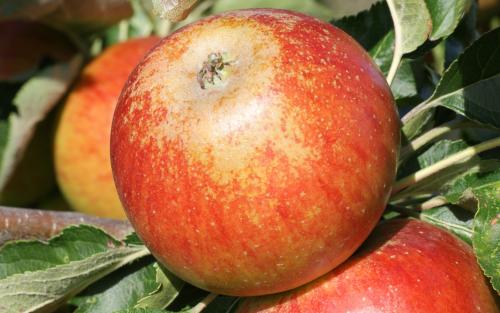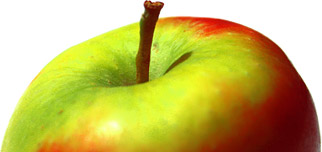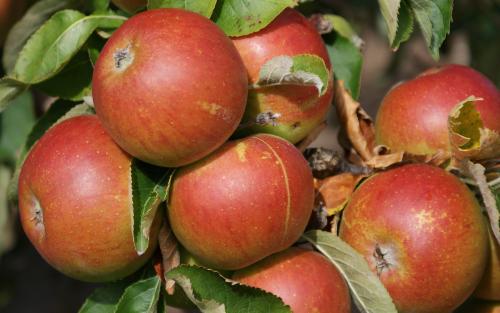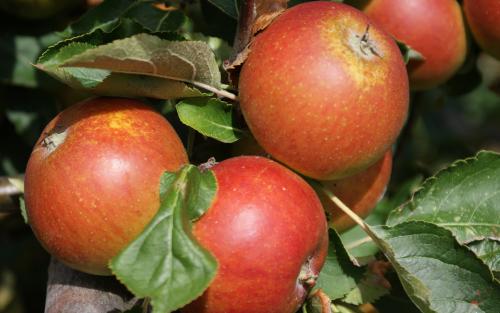
Medium-large fruit, gold-yellow flushed and striped orange-red. Flesh yellowish-cream. Firm and fairly juicy. Flesh rather coarsely textured, crisp.
Suntan apple identification images
All images copyright Orange Pippin unless otherwise stated.
USDA identification images for Suntan
The identification paintings in the USDA Pomological Watercolor Collection span the years 1886 to 1942.
Citation: U.S. Department of Agriculture Pomological Watercolor Collection. Rare and Special Collections, National Agricultural Library, Beltsville, MD 20705.
Parents and other ancestors of this variety
- Court Pendu Plat (parent)
- Cox's Orange Pippin (parent)
Sports of this variety
Sports are natural genetic mutations of the original variety.
Visitor reviews
- 05 Nov 2022My favourite apple for flavour. Unfortunately it's an unreliable cropper as it is a triploid and flowers late when many other varieties have finished. Has a sharp sweet taste and stores really well.
- 09 Oct 2022Has a nice tang.
- 28 Nov 2014 SOMERSET, United KingdomI have about 17 varieties of apple tree in my orchard and the flavour of Suntan is easily the best of them all. It is quite sharp and very sweet. I agree that, like its parent Cox, it is prone to cancer and other fruit diseases in this region, nevertheless I usually have a large healthy crop from each tree. The slightly yellowy apples have a nicer taste than the red blushed ones to my mind.
- 15 Jul 2011 CAMBRIDGESHIRE, United KingdomThe tree is slightly prone to canker and alos quite prone to powdery mildew. Early in the season the fairly large fruits suffer considerable damage from codling and sawfly maggots, although the pest attacks switch to other, more colourful, early-ripening varieties after a few weeks, so the whole crop is not generally lost. The mildew-prone tendency makes it unsuitable for dry regions, while the canker-prone tendency makes it unsuitable for wet regions. Not recommended unless it will be sprayed. I removed my (MM106/Suntan) tree and replaced it with a less troublesome variety.
Tree register
United States
- Axel Kratel in Santa Cruz, CALIFORNIA
- Dan Fitzpatrick in Paw Paw, LEE / IL
- Gil Schieber in Snohomish, WASHINGTON
- Jerry Hudgins in Point Reyes Station, CALIFORNIA
- Michael Le Boulluec in Glen Rock, PA
- Mike in Pennsylvania (south-central)
- Mike in Pennsylvania (south-central)
- Mike Haller in SIOUX CITY, IOWA
- Ricky Bruckner in Ravenna, OHIO (OH)
- Ryan Grover in Vineyard, UTAH
- Seth Powers in Mcindoe Falls, VERMONT
United Kingdom
- Alex in Scourie, SUTHERLAND
- Andrew C Ross in Eastleigh, HAMPSHIRE
- Graham Hinchliffe in Eastbourne, EAST SUSSEX
- Jean Lippett in Martock, SOMERSET
- Kevinincornwall in Liskeard, UNITED KINGDOM
- N. Buck in Cambridge, CAMBRIDGESHIRE
- Steve Sim in Grange Over Sands, CUMBRIA
- Stuart Mcqueen in Bury St Edmunds, SUFFOLK
- Tony in Glasgow, SCOTLAND
France
- BeN62 in Eclimeux,
Ireland
- James A Nolan in Glynn,, WEXFORD.
Italy
- Jan Huston in Castel D'Aiano, PROVINCIA DI BOLOGNA
Canada
- Clive Rose in SALT SPRING ISLAND, BRITISH COLUMBIA
Australia
- Hayden in Winslow, VICTORIA, AUSTRALIA
Spring blossom records for this variety
2023 season
- 16th May 2023 - tree owned by Stuart in Bury St Edmunds, United Kingdom
2022 season
- 15th May 2022 - tree owned by Stuart in Bury St Edmunds, United Kingdom
2020 season
- 28th April 2020 - tree owned by Jerry in Point Reyes Station, United States
2019 season
- 4th May 2019 - tree owned by Jerry in Point Reyes Station, United States
2018 season
- 7th May 2018 - tree owned by Jerry in Point Reyes Station, United States
2015 season
- 11th May 2015 - tree owned by Michael in Glen Rock, United States
2010 season
- 8th May 2010 - tree owned by N. in Cambridge, United Kingdom
2009 season
- 3rd May 2009 - tree owned by N. in Cambridge, United Kingdom
Record your blossom dates in our Fruit Tree Register - more >>.
Harvest records for this variety
2019 season
- 1st week October 2019 - tree owned by Jerry in Point Reyes Station, United States
2012 season
- 4th week September 2012 - tree owned by Andrew in Eastleigh, United Kingdom
2011 season
- August 2011 - tree owned by Jan in Castel D'Aiano, Italy
2009 season
- October 2009 - tree owned by N. in Cambridge, United Kingdom
Origins
- Species: Malus domestica - Apple
- Parentage: Cox's Orange Pippin x Court Pendu Plat
- Originates from: England, United Kingdom
- Introduced: 1955
- Developed by: East Malling Research
- UK National Fruit Collection accession: 1980-084
Identification
- Country of origin: United Kingdom
- Period of origin: 1950 - 1999
- Fruit colour: Orange flush
- Flower colour: White
- Annual cycle: Deciduous
- Flesh colour: Cream
- Fruit size: Large
- Awards: RHS AGM (former)
Using
- Picking season: Late
- Keeping (of fruit): 1-2 months
- Flavour quality: Very good
- Flavour style (apples): Aromatic
- Cropping: Heavy
- Fruit persistence: Normal ripening
- Food uses: Eating fresh
- Food uses: Juice
- Picking month: October
- Picking period: early October
- Wildlife: RHS Plants for Pollinators
Growing
- Gardening skill: Average
- Flowering group: 5
- Pollinating others: Poor
- Ploidy: Triploid
- Vigour: Very vigorous
- Bearing regularity: Regular
- Growth habit: Spreading / Flat-topped
- Fruit bearing: Spur-bearer
- Self-fertility: Not self-fertile
- Sunlight: Prefers full sun
Climate
- Cold hardiness (USDA): Zone 5 (-29C)
- Climate suitability: Temperate climates
- Climate suitability: Mild damp climates
- Cold-hardiness: Cold-hardy
- Summer average maximum temperatures: Cool ( 20-24C / 68-75F)
- Summer average maximum temperatures: Warm (25-30C / 76-85F)
Other qualities
- Disease resistance: Good
- Scab (Apple and Pear): Very resistant
- Powdery mildew: Very resistant
- Canker: Some susceptibility
Where to buy trees
The following tree nurseries offer Suntan apple trees for sale:
- Orange Pippin Fruit Trees (USA) United States
Suntan apple trees - Thomas Fruit Trees (EU) France
Suntan apple trees
Where to buy fresh fruit
The following orchards grow Suntan:
United States
Maine
- Tiny Orchards, Saco
Washington
- Skipley Farm, Snohomish *** Feature Orchard ***
United Kingdom
England - midlands
- Walsgrove Farm, Worcester
England - north
England - south-east
- Crapes Fruit Farm, Colchester
England - south-west
- Charlton Orchards, Taunton
Canada
British Columbia
- Apple Luscious Organic Orchards, Salt Spring Island
- Salt Spring Apple Company, Salt Spring Island
References
- Fruit Expert
Author: Hessayon



